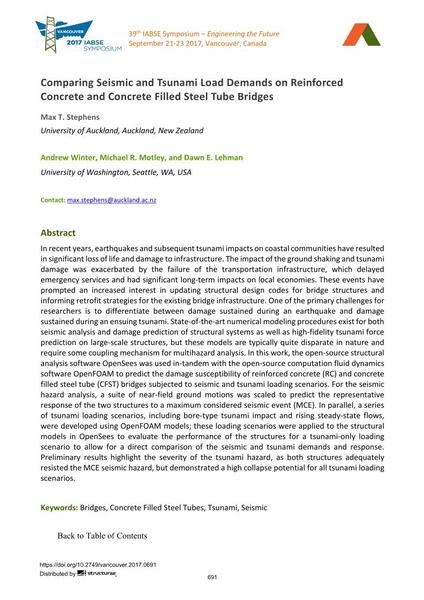Comparing Seismic and Tsunami Load Demands on Reinforced Concrete and Concrete Filled Steel Tube Bridges

|
|
|||||||||||
Bibliografische Angaben
| Autor(en): |
Max T. Stephens
(University of Auckland, Auckland, New Zealand)
Andrew Winter (University of Washington, Seattle, WA, USA) Michael R. Motley (University of Washington, Seattle, WA, USA) Dawn E. Lehman (University of Washington, Seattle, WA, USA) |
||||
|---|---|---|---|---|---|
| Medium: | Tagungsbeitrag | ||||
| Sprache(n): | Englisch | ||||
| Tagung: | IABSE Symposium: Engineering the Future, Vancouver, Canada, 21-23 September 2017 | ||||
| Veröffentlicht in: | IABSE Symposium Vancouver 2017 | ||||
|
|||||
| Seite(n): | 691-698 | ||||
| Anzahl der Seiten (im PDF): | 8 | ||||
| Jahr: | 2017 | ||||
| DOI: | 10.2749/vancouver.2017.0691 | ||||
| Abstrakt: |
In recent years, earthquakes and subsequent tsunami impacts on coastal communities have resulted in significant loss of life and damage to infrastructure. The impact of the ground shaking and tsunami damage was exacerbated by the failure of the transportation infrastructure, which delayed emergency services and had significant long-term impacts on local economies. These events have prompted an increased interest in updating structural design codes for bridge structures and informing retrofit strategies for the existing bridge infrastructure. One of the primary challenges for researchers is to differentiate between damage sustained during an earthquake and damage sustained during an ensuing tsunami. State-of-the-art numerical modeling procedures exist for both seismic analysis and damage prediction of structural systems as well as high-fidelity tsunami force prediction on large-scale structures, but these models are typically quite disparate in nature and require some coupling mechanism for multihazard analysis. In this work, the open-source structural analysis software OpenSees was used in-tandem with the open-source computation fluid dynamics software OpenFOAM to predict the damage susceptibility of reinforced concrete (RC) and concrete filled steel tube (CFST) bridges subjected to seismic and tsunami loading scenarios. For the seismic hazard analysis, a suite of near-field ground motions was scaled to predict the representative response of the two structures to a maximum considered seismic event (MCE). In parallel, a series of tsunami loading scenarios, including bore-type tsunami impact and rising steady-state flows, were developed using OpenFOAM models; these loading scenarios were applied to the structural models in OpenSees to evaluate the performance of the structures for a tsunami-only loading scenario to allow for a direct comparison of the seismic and tsunami demands and response. Preliminary results highlight the severity of the tsunami hazard, as both structures adequately resisted the MCE seismic hazard, but demonstrated a high collapse potential for all tsunami loading scenarios. |
||||
| Stichwörter: |
Brücken
|
||||
